A Pictorial Sampling of Curtiss-Wright Cyclone 9
Engine Data Plates
by Carl Kuhns
A Brief History of the Wright Cyclone 9
The first Wright engine to use the name “Cyclone” was the P-1. A nine-cylinder static radial engine of 1,654 in³ displacement, the P-1 was introduced in 1924. It was followed by the P-2 in 1925. In 1927, the R-1750 Cyclone was introduced. In 1930, the definitive Cyclone 9, the R-1820, was introduced. This engine was in continuous production until mid-1964.
The E series was the first of eight successive series, starting in July 1930. The E series was followed by the F, G, G-100, G-200, HC, HD, and HE series.
Cyclone 9 data plates have either a standardized military model designation or a Wright Aeronautical Division (WAD)-supplied model number. Sometimes one or two letters appear after a military style engine data plate. The letter or letters refer to different installed accessories, different reduction gearing, different installations, or engine modifications. An example of a military model designation is R-1820-72A. An example of a WAD model number is 989C9HE2.
Cyclone 9 Producers
During the R-1820’s production period, these engines were made by Wright in Paterson, New Jersey and Wood-Ridge, New Jersey. During World War II, when automobile production was halted, Studebaker in South Bend, Indiana manufactured Cyclone 9s. After World War II, Lycoming in Stratford, Connecticut was an R-1820 licensee. In the mid-1950s, Canadian Pratt & Whitney made HE Series Cyclone 9s in Longueuil-Montreal Canada under license from Curtiss-Wright of Canada.

E Series
Wright Aeronautical Corporation
Paterson, New Jersey
R-1820E
|
| Applications — | Consolidated C-22, Model 17-2AC |
| Normal Rating — | 575 HP at 1,900 RPM with 80 grade fuel |
| Reduction Ratio — | 1:1 |
| Blower Ratio — | 10.5:1 |
| WAC R-1820E Production — |
721 engines |
| WAC R-1820E Production Period — |
July 1930 ~ August 1935 |
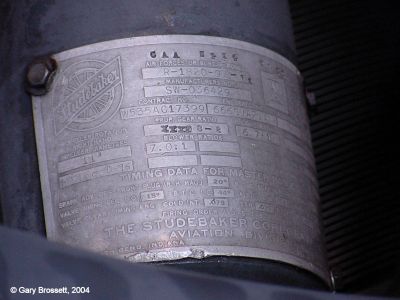
G200 Series
Studebaker Corporation
Aviation Division
South Bend, Indiana
R-1820-97 G200 series
|
| Applications — | Boeing B-17F, B-17G, B-17H |
| Type Certificate — | 5E-10 |
| Takeoff Rating — | 1,200 HP at 2,500 RPM with 100 grade fuel and turbosupercharger |
| Reduction Ratio — | The factory-installed reduction ratio for the R-1820-97 G200 series was 0.5625:1. The engine that carried this data plate had been modified with a reduction ratio of 3:2 (0.666:1) |
| Blower Ratio — | 7:0.1 |
| Studebaker R-1820-97 Production — | 60,285 engines |
| Studebaker R-1820-97 Production Period — | October 1942 ~ June 1945
Between March 1942 and June 1945, Studebaker produced 63,789 G200 Series R-1820-65 and R-1820-97 engines. Except for an unknown large number of Cyclone 9s built in Russia, the Studebaker engines totaled over half of all R-1820s. Of the 119,975 USA-built Cyclone 9s, only 568 were R-1750s. |
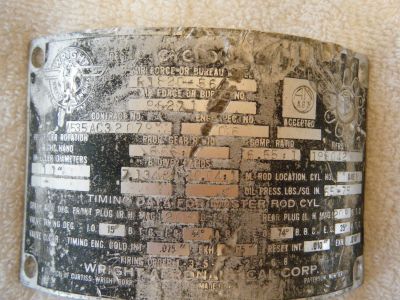
HC Series
Wright Aeronautical Corporation
Paterson, New Jersey
R-1820-56 similar to 806C9HC1 |
| Applications — | Eastern FM-2 |
| Type Certificate — | SE-10 |
| Takeoff Rating — | 1,300 HP at 2,600 RPM with 100 grade fuel |
| Reduction Ratio — | 0.666:1 |
| Blower Ratios — | 7.1348:1 (low), (high) 10.04:1 |
| WAC R-1820-56 Production — |
2,186 engines |
| WAC R-1820-56 Production Period — |
October 1942 ~ May 1944 |

This data plate appears to have been re-stamped to a -76C from either a -76A or a -76B.
HD Series
Bridgeport–Lycoming
Division AVCO Manufacturing Corp.
Stratford, Connecticut
R-1820-76C similar to 826C9HD3 |
| Applications — | Grumman Albatross SA-16 |
| Type Certificate — | 5E-10 |
| Takeoff Rating — | 1,425 HP at 2,700 RPM with 100/130 grade fuel |
| Reduction Ratio — | 0.666:1 |
| Blower Ratios — | 7.21:1 (low), 10.14:1 (high) |
| Lycoming R-1820-76A and-76B Production — | 988 engines |
| Lycoming R-1820-76A and-76B Production Period — | 1952 ~ 1957 |

HD Series
Wright Aeronautical Division
Wood-Ridge, New Jersey
987C9HD1 |
| Applications — | Learstar Mark 1 |
| Type Certificate — | E-243 |
| Takeoff Rating — | 1,425 HP at 2,700 RPM with 100/130 grade fuel |
| Reduction Ratio — | 0.666:1 |
| Blower Ratios — | 7.21:1 (low), 10.14:1 (high) |
| WAD 987C9HD1 Production — | 5 engines |
| WAD 987C9HD1 Production Period — | April 1958 ~ October 1958 |
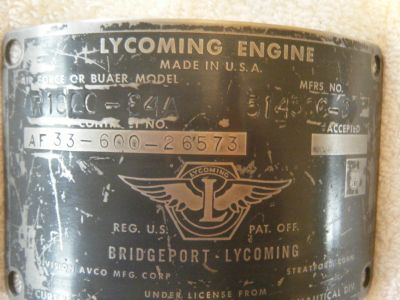
HE Series
Bridgeport–Lycoming
Division AVCO Manufacturing Corporation
Stratford, Connecticut
R-1820-84A similar to 895C9HE1 |
| Applications — | Military Versions of the Sikorsky S58 Helicopter |
| Type Certificate — | 259 |
| Takeoff Rating — | 1,525 HP at 2,500 RPM with 115/145 grade fuel |
| Reduction Ratio — | 1:1 |
| Blower Ratio — | 7.21:1 |
| Lycoming R-1820-84 Production — | 1567 engines |
| Lycoming R-1820-84 Production Period — | 1954 ~ 1958 |

HE Series
Bridgeport–Lycoming
Division AVCO Manufacturing Corporation
Stratford, Connecticut
R-1820-82 similar to 982C9HE3 |
| Applications — | Grumman Albatross G111, a conversion of the military Albatross to a civil airline configuration. |
| Type Certificate — | 5E-10 |
| Takeoff Rating — | 1,475 HP at 2,800 RPM with 100/130 grade fuel |
| Reduction Ratio — | 0.5625:1 |
| Blower Ratio — | 7.21:1 |
| Lycoming 982C9HE Series Production — | 13 engines |
| Lycoming 982C9HE Series Production Period — | 1955 ~ 1956 |

HE Series
Wright Aeronautical Corporation
Paterson, New Jersey
R-1820-80A similar to 968C9HE1 |
| Applications — | Navy R4D-8, Douglas Super DC-3 |
| Type Certificate — | E-259 |
| Takeoff Rating — | 1,475 HP at 2,800 RPM with 100/130 grade fuel |
| Reduction Ratio — | 0.5625:1 |
| Blower Ratio — | 7.21:1 |
| WAC R-1820-80 Production — |
266 engines |
| WAC R-1820-80 Production Period — |
December 1950 ~ December 1952 |
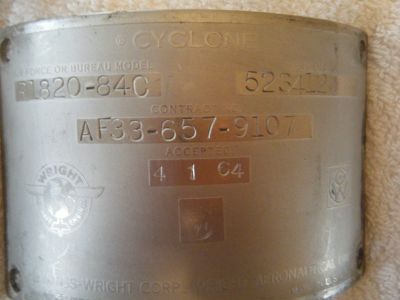
HE Series
Wright Aeronautical Division
Wood-Ridge, New Jersey
R-1820-84C similar to 989C9HE2 |
| Applications — | Military Version of the Sikorsky S58 Helicopter |
| Type Certificate — | E-259 |
| Takeoff Rating — | 1,525 HP at 2,500 RPM with 115/145 grade fuel |
| Reduction Ratio — | 1:1 |
| Blower Ratio — | 7.21:1 |
| WAD R-1820-84C Production — | At least 119 engines, as of December 1963; Total Number Unknown |
| WAD R-1820-84C Production Period — | 1961 ~ late 1964 |
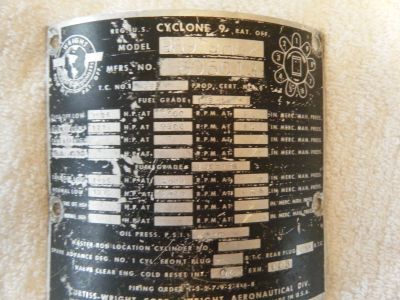
HE Series
Wright Aeronautical Division
Wood-Ridge, New Jersey
989C9HE2 |
| Applications — | Sikorsky S58 Helicopter |
| Type Certificate — | E-259 |
| Takeoff Rating — | 1,525 HP at 2,800 RPM with 115/145 grade fuel
1,425 HP at 2,800 RPM with 100/130 grade fuel |
| Reduction Ratio — | 1:1 |
| Blower Ratio — | 7.21:1 |
| WAD 989C9HE2 Production — | 285 engines |
| WAD 989C9HE2 Production Period — | October 1956 ~ August 1963 |

Canadian Pratt & Whitney Aircraft
Longueuil, Montreal 25 P.Q. Canada
983C9HE1 |
| Canadian Pratt & Whitney Aircraft built an HE series Cyclone 9 under license from Curtiss-Wright of Canada. It powered Grumman S2F trackers, which were built by de Havilland Canada under license from Grumman. The P&W engines were similar to the American tracker engines (R-1820-82WA), except the master rod was located in cylinder number five instead of number one. This modification was said to improve reliability. |
| Canadian Pratt & Whitney 983C9HE1 Production — | 287 engines |
Sources
Type Certificate E-243
Type Certificate E-259
Type Certificate TC 5E-10
Radio Research Paper - Tracker In Canadian Service
Grumman G-64/111 Albatross
Curtiss-Wright Engine Specs, 1930 - 1983 (4.3M PDF)
Wright Aeronautical Division (and Licensee) Shipments, 1920 - 1964 (5.1M PDF)
Cyclone 9 Facts (0.9M PDF)
Wright Aircraft Engines, Military Helicopter Installation,
Cyclone 7 and Cyclone 9 Models.
Curtiss Wright Corportation, Wood-Ridge New Jersey, March 1959.










